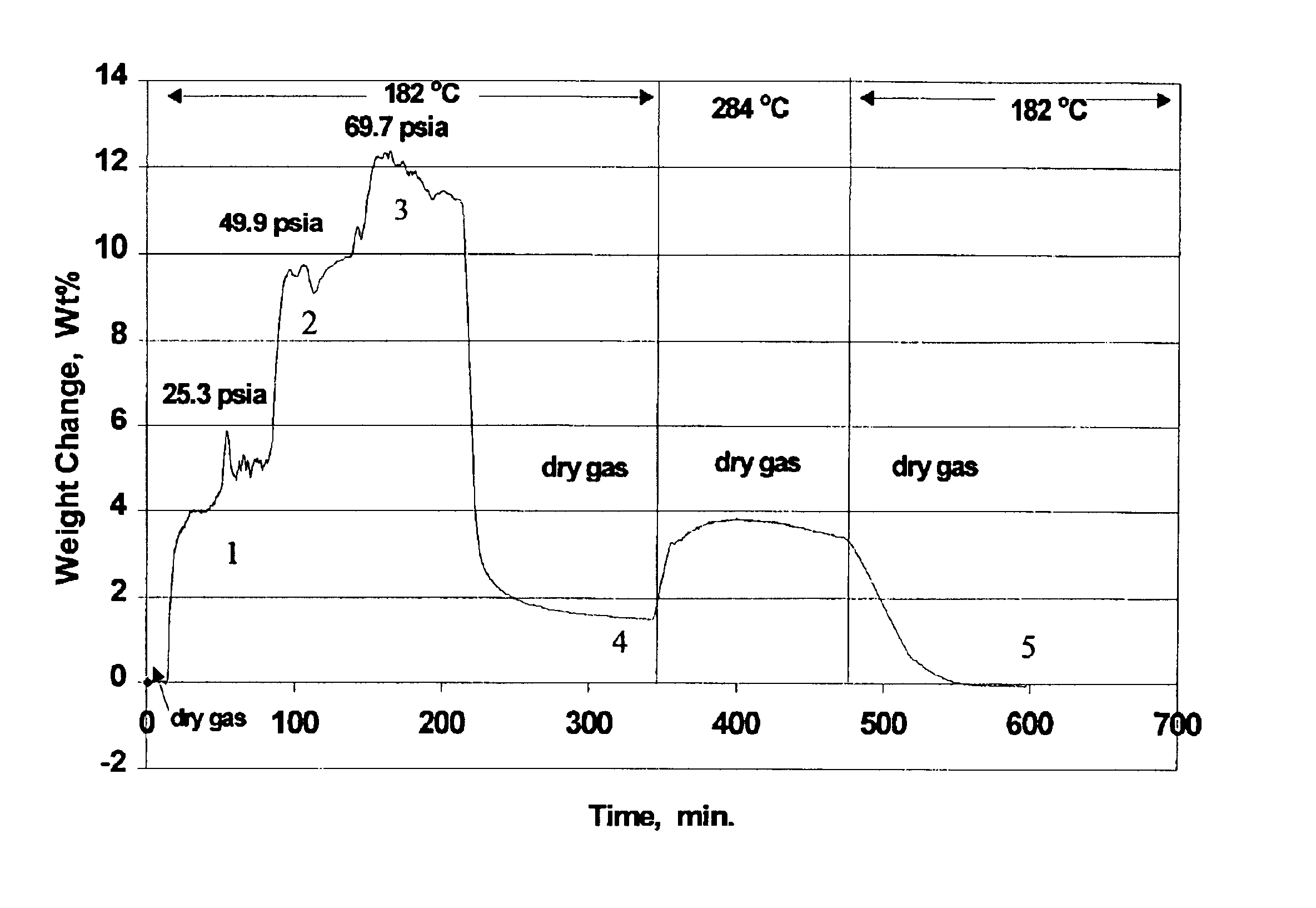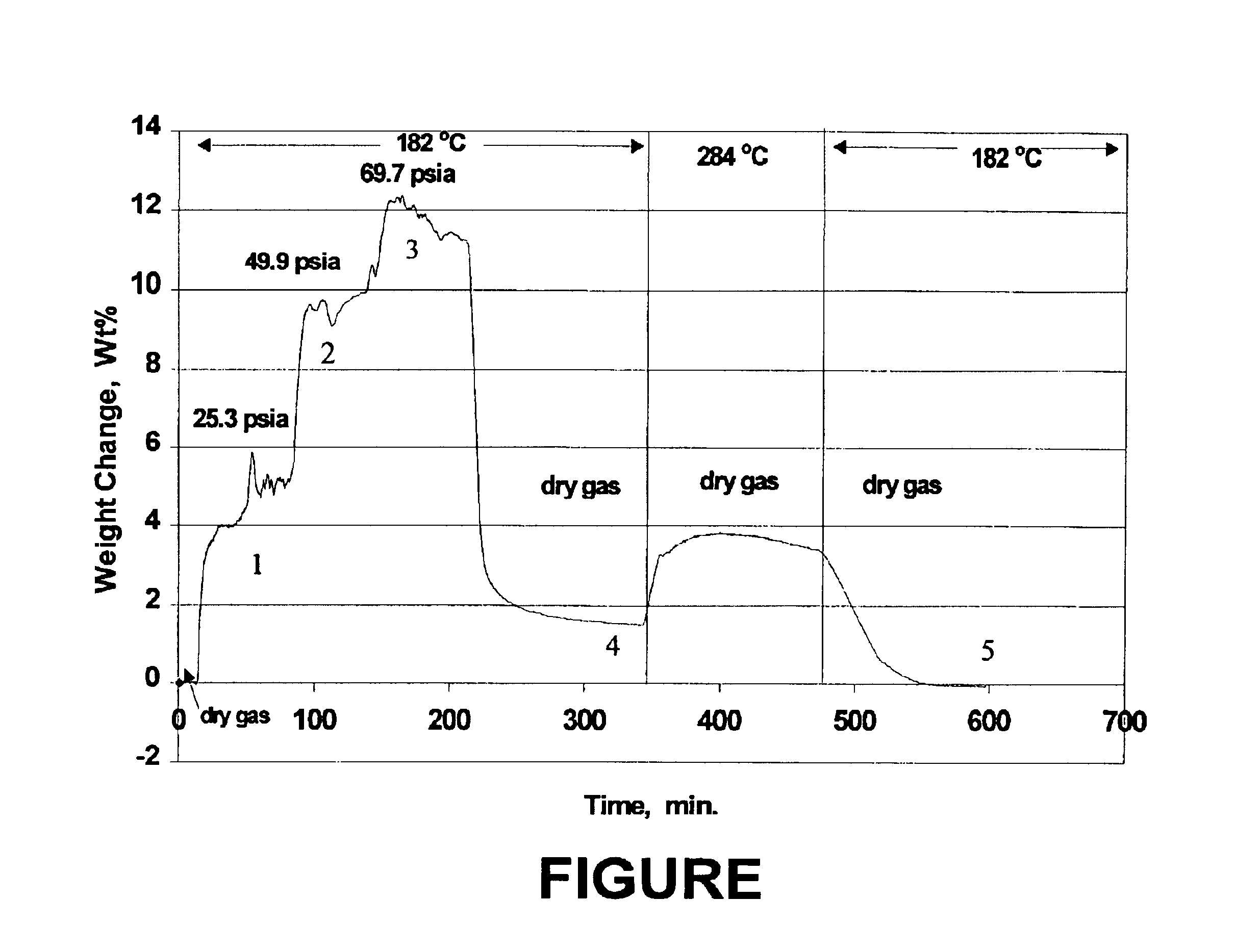Method of protecting SAPO molecular sieve from loss of catalytic activity
a technology of metalloaluminophosphate and molecular sieve, which is applied in the direction of catalyst activation/preparation, physical/chemical process catalysts, chemistry apparatus and processes, etc., can solve the problems of increasing the difficulty of protecting the molecular sieve from the loss of catalytic activity as a result of contact with moisture, and the limited methods of protecting the active sapo molecular sieve against the harmful effects of moisture, etc., to achieve the most effectiv
- Summary
- Abstract
- Description
- Claims
- Application Information
AI Technical Summary
Benefits of technology
Problems solved by technology
Method used
Image
Examples
example 1
[0144]About 40 mg of catalyst particles were loaded into the sample cell of a microbalance (conventional thermal gravimetric analyzer, TGA). The catalyst was calcined with air at about 650° C. for more than 4 hours at atmospheric pressure, then cooled down under dry inert gas (containing no water) to the adsorption temperature. The inert gas flow rate was 150 scc / min (at standard conditions) and the pressure in the TGA was 119.7 psia. After a stable weight was established, water was injected into the dry inert gas at a control rate through a vaporizer. This provided a controlled steam flow rate (cc / min at standard condition). The inert gas flow was decreased by the same amount so that the total flow rate was kept at 150 scc / min. The partial pressure of steam in the gas mixture flowing to the catalyst was calculated as
P=(steam flow rate / 150)*119.7 psia
[0145]When steam was added, the TGA recorded at first a fast increase in weight due to adsorption of water followed by a slower increa...
example 2
[0148]About 40 mg of catalyst particles were loaded into the sample cell of a microbalance (traditional thermal gravimetric analyzer, TGA). The catalyst was calcined with air at about 650° C. for more than 4 hours at atmospheric pressure, then was cooled down under dry inert gas (containing no water) to the adsorption temperature, 180-184° C. The inert gas flow rate was 150 scc / min (at standard condition) and the pressure in the TGA was 119.7 psia. After a stable weight was established, water was injected into the dry inert gas at a control rate through a vaporizer. This provided a controlled steam flow rate (cc / min at standard condition). The inert gas flow was decreased by the same amount so that the total flow rate was kept at 150 scc / min. The partial pressure of steam in the gas mixture flowing to the catalyst was calculated as
P=(steam flow rate / 150)119.7 psia
[0149]When steam was added to give 25.3 psia steam partial pressure as indicated in the FIGURE, the TGA recorded at first...
PUM
| Property | Measurement | Unit |
|---|---|---|
| temperature | aaaaa | aaaaa |
| temperature | aaaaa | aaaaa |
| temperature | aaaaa | aaaaa |
Abstract
Description
Claims
Application Information
 Login to View More
Login to View More - R&D
- Intellectual Property
- Life Sciences
- Materials
- Tech Scout
- Unparalleled Data Quality
- Higher Quality Content
- 60% Fewer Hallucinations
Browse by: Latest US Patents, China's latest patents, Technical Efficacy Thesaurus, Application Domain, Technology Topic, Popular Technical Reports.
© 2025 PatSnap. All rights reserved.Legal|Privacy policy|Modern Slavery Act Transparency Statement|Sitemap|About US| Contact US: help@patsnap.com



